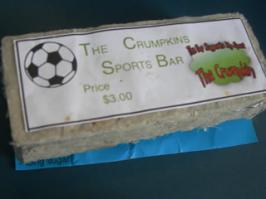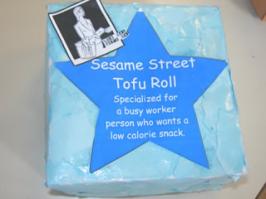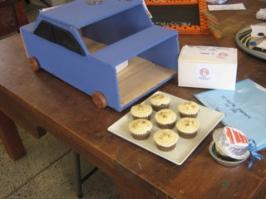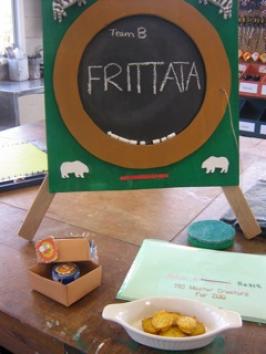Master Creator challenge
Getting inspiration from Master Chef
The Gardens School's Digital/Poutama Teacher Christine Hansen took inspiration from a popular reality TV program to create a Technology challenge that utilised multiple skill areas.
The Years 7-8 Technology programme at The Gardens School is set up to ensure students acquire fundamental skills in the first two terms, getting the basics in Food, Materials, and digital technologies, which are then put into practice in the following two terms with a challenge where teams compete to create projects ranging from go carts to team flags and, in this case, the Master Creator project. Christine runs the challenge for the Year 7 and 8 classes concurrently.
Christine explains that the inspiration for the Master Creator project came from the New Zealand Master Chef TV series that was airing at the time.
"We really wanted to do food for the challenge this time and Master Chef was on TV and the kids were talking about it in class, so that just started the thinking on it. "
The idea was to give students mystery boxes, each with a different selection of items that had to be incorporated into a fully developed healthy food product. The box also included a brief that explained the needs of a particular client stakeholder – this might be a school student with gluten intolerance, an office worker with high cholesterol, or an elderly person with chewing issues.
Unlike TV's Master Chef contestants, the students were to create a total package, with the food product supported by promotional materials such as videos, posters, and notice boards as well as packaging. The product also had to have the lowest possible environmental impact, the research of which had to be included with the product's nutritional value in the supporting paperwork for each project.
Preparation
Christine wanted to make the project challenging yet achievable, so began her own research into each of the briefs she had developed to ensure there were options available for the students. She also looked into the environmental and sustainable qualities of all of the product ideas.
Being an integrated learning environment, classroom teachers play a large role in the way Technology is taught at The Gardens School, so Christine's first challenge was to get the staff on board with the project, particularly those unfamiliar with some areas of the Technology learning area.
"I planned it so that we had everything ready for them so that it was as easy as possible. For example, with teachers not confident in digital or other areas, we made sure there were some students there who would be able to help them."
Once the staff was on-board, Christine introduced the mystery boxes to the students and put posters up around the school to create an atmosphere of anticipation before the unit began.
"Master Chef had just finished on TV so we followed through with that, getting the momentum going, hyping it up, and pre-selling it to the students," says Christine. "And they loved the mystery boxes which we had tied up with ribbons, and were really excited about them and were dying to know what was inside."
Christine also added an extra incentive for the winning teams.
"The prize for the two teams that won was a movie pass and some free popcorn, and they just thought that was wonderful."
Bringing in expertise
Christine was fortunate at this stage to have the support of an external local expert Gay Watson who agreed to be a judge for the competition. Gay also invited Bluebird food technologist Katie Hatton to visit the classes and introduce the concepts of product development to the students.
"We started the unit with Katie coming in and talking about the process of a product's design, production and marketing, and the teachers referred to what she said throughout the unit when talking to the students."
The student teams were then able to open their mystery boxes, which held their briefs and the materials they had to incorporate within their products, ranging from tofu, cranberries, almonds and pumpkin for the Food section and wire, hosing, metal and wood for Hard materials.
"All contents of the mystery box had to be used, although other ingredients could be added to the final product, which had to have as low an environmental impact as possible. This meant thinking about things like what sort of timbers they were using and where their materials came from, so making them look at it from the social side of things."
Stakeholder surveys and brief development
After conducting surveys on their stakeholder's likes and dislikes, the students rewrote their assigned brief based on this information and the ingredients available to them in the food room.
With their brief redefined, the students started organising their total product package, breaking the teams into Food, Resistant materials, Packaging and Advertising - design and visual communication (DVC), with two people from each team chosen for their strengths in these areas.
Because the advertising and promotional sections needed a finalised food product from the food team before they could begin designing their work, Christine staggered different components of the challenge for the separate sectors within each team – so while the food product was being developed the other sectors focussed on their research component.
On the day of judging, the products varied from muffins and biscuits to tofu and sushi, while support materials took the form of noticeboards, posters and short advertisements – live action or animated – which were played to the judges on laptops.
Winning through teamwork
Christine says that while many teams produced some impressive outcomes, the groups that were consistent in all areas took the final awards.
"Some of the outcomes stood out, but they didn't necessarily win as the paperwork let some teams down. It was much more about everybody in the team doing their bit, so it really was about the whole thing. The product had to taste good with everything presented well, but they also had to have all the backup documentation and research."
The Gardens School's Associate Principal Kate Gifford helped judge the competition and felt that the way the teams were structured had extremely positive effects on student responsibility and enjoyment.
"I think it was good that they were in pairs within the bigger groups so each student could pick something that was interesting to them and that they were all actively involved, rather than a group of four where two might do a lot and two might do very little," says Kate. "It was also great to see how the groups came together, where you could see a really good link between all their products, and that put the onus on the students to look and see whether they had made a good contribution or not."
Motivation through engagement
Christine is happy with how the Master Creator challenge turned out, especially the student's reaction to it throughout the two terms.
"Student enthusiasm, even right to the end where they still wanted to win, was terrific. They were motivated throughout and I think that was because all the groups were really involved in the whole outcome even if they had separate tasks. So the packaging kids could still come and taste test what the food kids were making and give their feedback throughout."
"The students worked together well as a team, were very independent and learned a lot about how to make a proper decision, so I do think it covers those key competencies really well."





